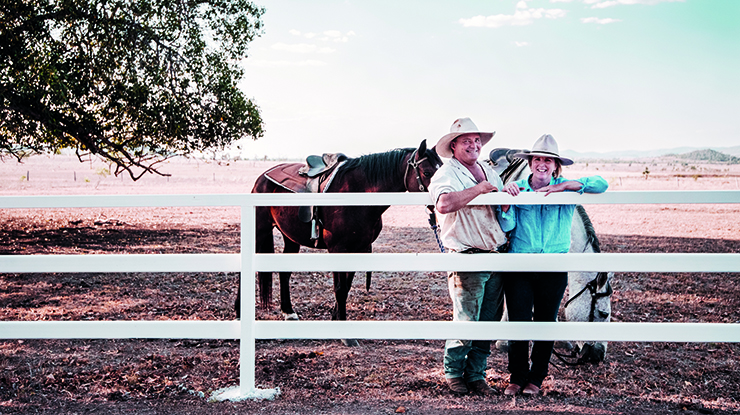
Melinee and Rob Leather use biosecurity as a tool to protect their own business, as well as contribute to the integrity of the whole industry.
The Leathers take a measured approach to preventing disease, managing pest and weed threats, and practising animal welfare to protect their access to vital beef export markets.
"Our markets demand biosecurity – without it, nothing else really matters. Biosecurity affects the health of our livestock, our environment, even our people, and it's everyone's responsibility," Melinee said.
"The latest outbreak in Indonesia of foot-and-mouth disease and lumpy skin disease really highlighted that if we don't make sure these things stay out, our market access potentially is at risk."
With their son Adam and his wife Chloe, Rob and Melinee run a 5,000‑head Brahman‑based herd to produce animals suitable for EU and organic markets, and Teys' Grasslands beef program.
Cattle are bred at 'Four Mile' and 'Hazeldean', North Burnett, and finished at 'Barfield Station' near Banana. Barfield is also home to a small organic breeding operation.
Operating strict biosecurity measures is paramount to ensure movement of cattle between properties does not introduce pests or weeds, and to maintain their organic accreditation at Barfield.
This commitment to avoiding the spread of pests underscores the importance of the mindset that biosecurity begins at home – it's not solely concerned with safeguarding against the incursion of exotic diseases.
"It's essential to never underestimate the importance of biosecurity," Melinee said.
"We've consistently made it an everyday part of our business and have never had problems with diseases, pests or weeds being introduced onto our properties."
The Leathers' biosecurity strategies include:
Quarantine: all incoming cattle spend a minimum 21 days in a quarantine paddock before entering the main grazing paddocks. This also helps cattle settle and adjust to the new environment, water and feed.
Surveillance: cattle are checked daily during the quarantine period for any health issues.
Buying cattle: purchased cattle must have animal health statements and up‑to‑date vaccinations, and bulls must also be backed by soundness tests.
Visitors: visitor movement is limited. Visitors can bring vehicles as far as the house – only farm vehicles are allowed to move around the rest of the property.
Vehicle hygiene: visiting vehicles, including contractors, must be cleaned and washed down before entry to the property. The Leathers also wash down their own vehicles when moving between properties.
Signage: biosecurity signs on gates provide contact numbers for visitors to call before entering.
Tech helps make biosecurity easy
Biosecurity plans and animal health procedures (including using pain relief for husbandry practices) form part of staff induction and training, along with other workplace health and safety processes.
Melinee said establishing effective property biosecurity plans doesn't have to be time consuming.
"We use the feralSCAN apps to record the number of pigs and wild dogs quickly and easily on our properties," Melinee said.
"We're using the app nearly every day across the three properties because we've got a big incursion of pigs and wild dogs at the moment."
She also uses Animal Health Australia's farm biosecurity plan template and relies on the FarmBiosecurity app to keep records of weeds, store photos and information about each property.
Melinee said that as well as making sense from farm biosecurity and animal health perspectives, their stringent policies support annual auditing to maintain their Grazing Best Management Practice, EU, organic, Teys' Grasslands program and LPA accreditations.
Biosecurity for your region
According to Melinee, there is real value to be had in a regional effort to improve biosecurity.
"Taking a regional approach to biosecurity is important. Neighbours and regions should come together to have a more concise regional plan and share ideas about the ways of keeping things under surveillance – and if your region does get an incursion, discuss how you are going to protect your area," Melinee said.
"We've approached our local natural resource management organisation, the Fitzroy Basin Association and the Department of Agriculture, Fisheries and Forestry about running coordinated planning sessions within our area. The planning sessions will include key stakeholders along the supply chain such as local transporters, our close abattoirs and local government.
"As a group, we can come up with ideas to have better surveillance and better management if there is an incursion. We will also be discussing the availability of key biosecurity resources such as wash down bays for vehicles and effluent dumps for trucks in our region."
Lessons learned
- Quarantine livestock coming onto your property.
- Request animal health statements when buying cattle.






